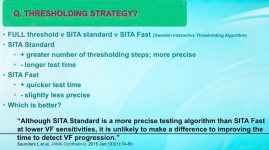Another example of science being ahead of guidelines, rules and regulations.
I find it interesting to see the initial acceptance of everything Dr. Lakkis had to say, but alternatively, I sometimes find resistance among the ODwire membership when similar statements are made about clinical information in other domains.
Dr. Lakkis, great lecture.
There should never be blind acceptance of any scientific theory, including those I presented, which are not my work but those of respected colleagues.
In fact Andrew Anderson who is an OD/PhD at our institution doesn’t necessarily agree this is the best approach:
Detecting glaucomatous progression with infrequent visual field testing.
Anderson AJ, et al. Ophthalmic Physiol Opt. 2018.
Show full citation
Abstract
PURPOSE: Previous work has investigated whether a significant regression slope in the first 2 years for the summary index Mean Deviation (MD) is predictive of rapid (≤-2 dB/year) glaucomatous visual field progression. This work assumed six visual fields were obtained as per management guidelines, but in clinical practice commonly only two or three fields are measured.
METHODS: We simulated visual field series (N = 100 000) spaced annually in the first 2 years and then biennially. We calculated positive and negative predictive values (PPV & NPV).
RESULTS: Prediction values at 2 years were slightly less than those obtained using six visual fields. An addition of an appropriate slope based criterion materially improved PPV, with little detrimental effect.
CONCLUSION: Infrequent visual field testing does not dramatically alter predictive values at 2 years, but does substantially delay when significant progression may first be detected.
© 2018 The Authors Ophthalmic & Physiological Optics © 2018 The College of Optometrists.





